In honor of the 40th anniversary of CUNY’s Center for Puerto Rican Studies/Centro de Estudios Puertorriqueños, several New York-based Puerto Rican artists joined forces to create a portfolio of silk-screened prints. Both the print project and an associated exhibition held this fall were titled “nu-YO-Rican.”
CUNY’s Center for Puerto Rican Studies/Centro de Estudios Puertorriqueños at Hunter College – often referred to simply as Centro – notes that it “was founded in 1973, amid the era of the great wakening of demands for social justice for minorities of all types – by ethnicity, race, color, gender, physical ability, and age. Centro, with its base within the academy, was born as part of these efforts.”
In honor of Centro’s 40th anniversary, several New York-based Puerto Rican artists have joined forces to create a portfolio of silk-screened prints. The title given to both the print project and an associated exhibition held this fall at the East Harlem Art Gallery in the Hunter School of Social Work was “nu-YO-Rican.”
For more information on the print portfolio, visit tinyurl.com/nu-YO-Rican-prints. To learn more about Centro, visit centropr.hunter.cuny.edu.
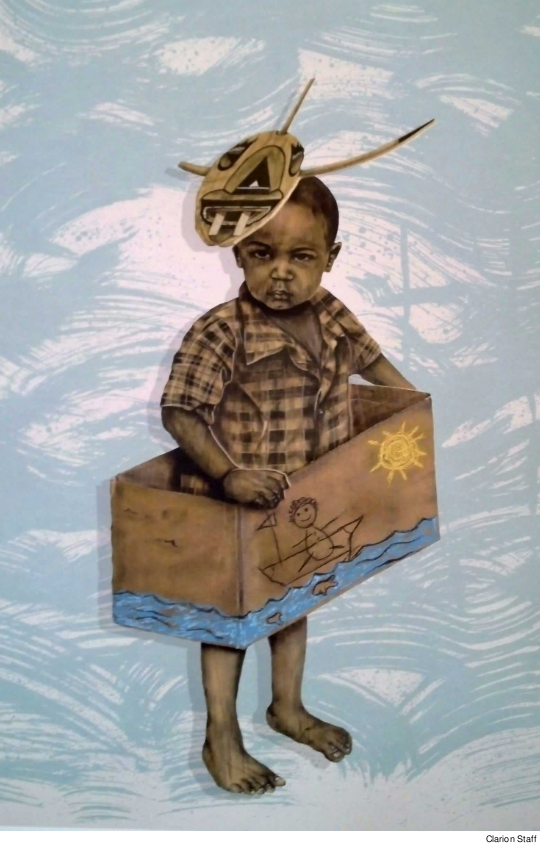 |
“Aguas de Libertad” by Adrian “Viajero” Roman
This print is based on one of Roman’s “cutout” works of the same title that uses charcoal and graphite on wood and pastels on cardboard. Roman describes of its genesis: “’Aguas de Libertad’ was created for an exhibit at the Brennan Gallery (NJ) called ‘ves•sel.’ A fusion of both literal and metaphorical interpretations of ‘container,’ ‘ship,’ ‘body,’ and ‘blood,’ ‘ves•sel’ seeks to emphasize American-ness of Black History…. “Aguas de Libertad” was inspired by the abolitionist movement in Puerto Rico, led by Ramón Betances, to free children who were slaves, taking advantage of their need to receive the sacrament of baptism at the town church. Buying the freedom of slave children cost more if the child had been baptized. [So] before the child was baptized, Betances or his partners gave money to the parents, which they in turn used to buy the child’s freedom from his or her master. However, the child, once freed, was baptized minutes after. This action was later described as having the child receive the aguas de libertad (waters of liberty).”
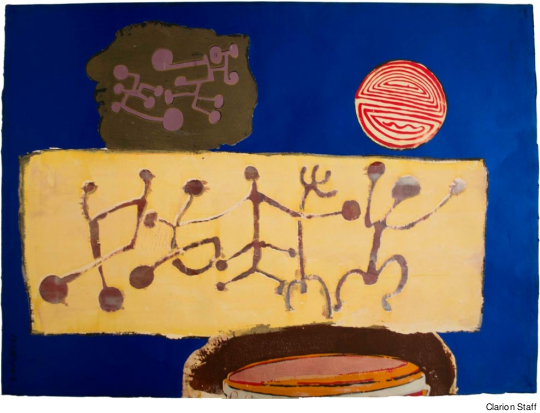
“Areito Jam” by Marcos Dimas
Areito is “a ceremonial dance, music and storytelling [in] the tradition of the Taino people,” says Centro’s catalog for the portfolio. Here is some of what Dimas has written about his use of Taino imagery in this and other works: “I was born on a sugar plantation in Puerto Rico…. During my childhood explorations, I discovered shards of pottery carved with images created by the Taino Indians. Following my involvement with the Art Workers Coalition during the late ‘60s and then co-founding the Taller Boricua, an artists’ collective, in 1970, I decided to forsake my early training in modern art to begin a quest for alternative sources. This led me to embrace the art of the extinct Taino Indian peoples of my homeland, Puerto Rico. My mission would be to pay homage to, and encourage the revival of, the art of my spiritual ancestors.”
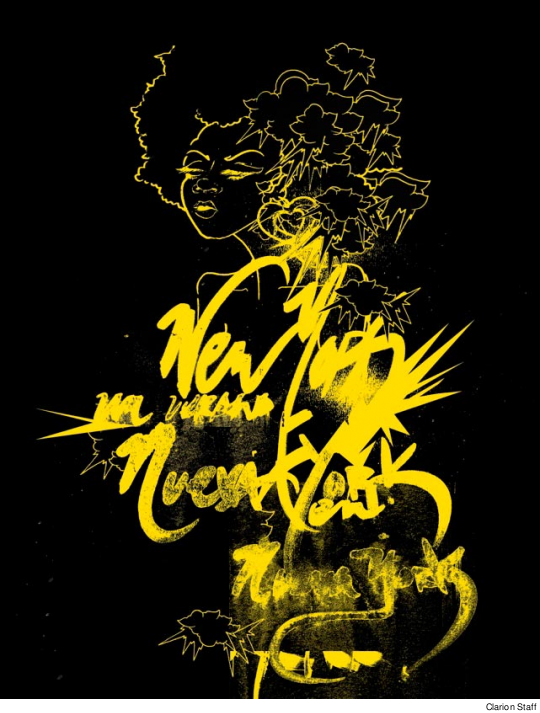
“Un Verano en Nueva York” by Sofía Maldonado
From the portfolio catalog: “Painter and muralist Sofía Maldonado loves summers in New York City. She admits she loves them more than in her tropical Puerto Rico because, says Maldonado, who lives in Brooklyn and was born and raised in Puerto Rico, ‘New York in the summer is the most Puerto Rican feeling time in the city. As the song [the salsa classic ‘Un Verano en Nueva York’] says, it is the best time to be in New York. A summer in New York is so different from Puerto Rico.’ She mentions open fire hydrants in the barrios as an example. In New York, you only have the summer to enjoy the heat and ‘you just want to go outside and go to the water.’ For Maldonado, summers in New York are simply ‘one of the most authentic Nuyorican moments.’”
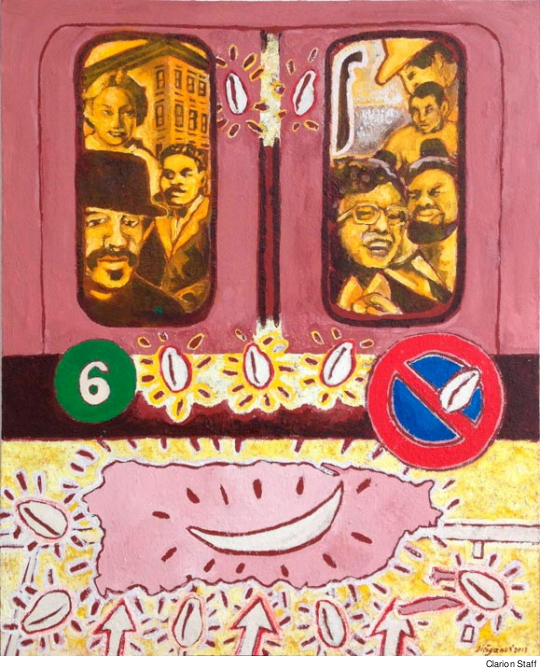
“Newyorican Manifestation / Manifestación Nuyorican” by Diógenes Ballester
From Ballester’s remarks in a panel discussion at the exhibition opening: “When I immigrated to New York City in 1981 from La Playa de Ponce, Puerto Rico… I did not share the unique experiences of the Nuyorican who had come to New York as…[a] youth or had been born here. They had navigated a school system that had not yet learned to embrace bilingualism. They had experienced, growing up, the northeast US brand of racism. They resisted oppression and created their own institutions, including el Centro. These common experiences, among many others, contributed to the forging of a collective Nuyorican identity that both looked back to the island roots, but also embraced what it meant to have grown up on these streets…. So when I was invited to be part of this portfolio, my reflections on the differences between my Nuyorican brothers and sisters and myself served as a starting point.”
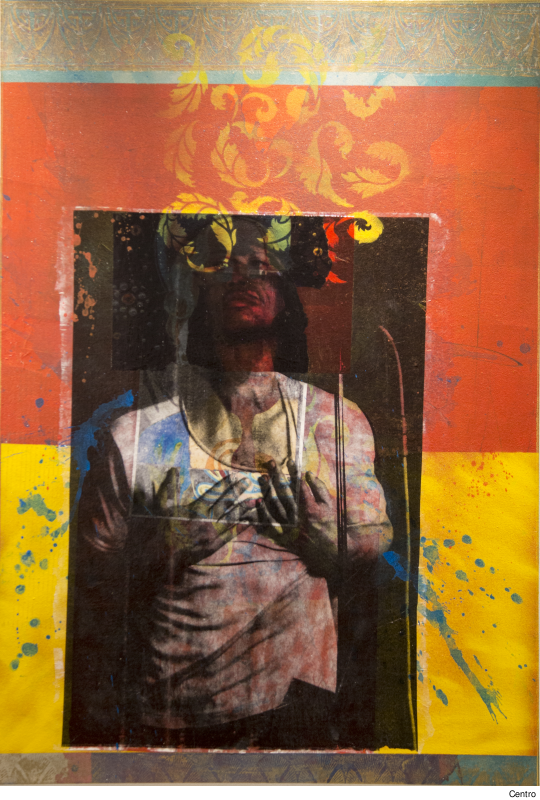
“Amanece” by Rodriguez Calero
From the portfolio catalog: “The title ‘Amanece’ comes from the awakening, the start, the new dawn, the inner strength and never-ending struggles that we deal with as a people and…as individuals,” she says. “It represents dignity and elevates our spiritual values, which manifests our destiny and resilience in the Puerto Rican diaspora.”

